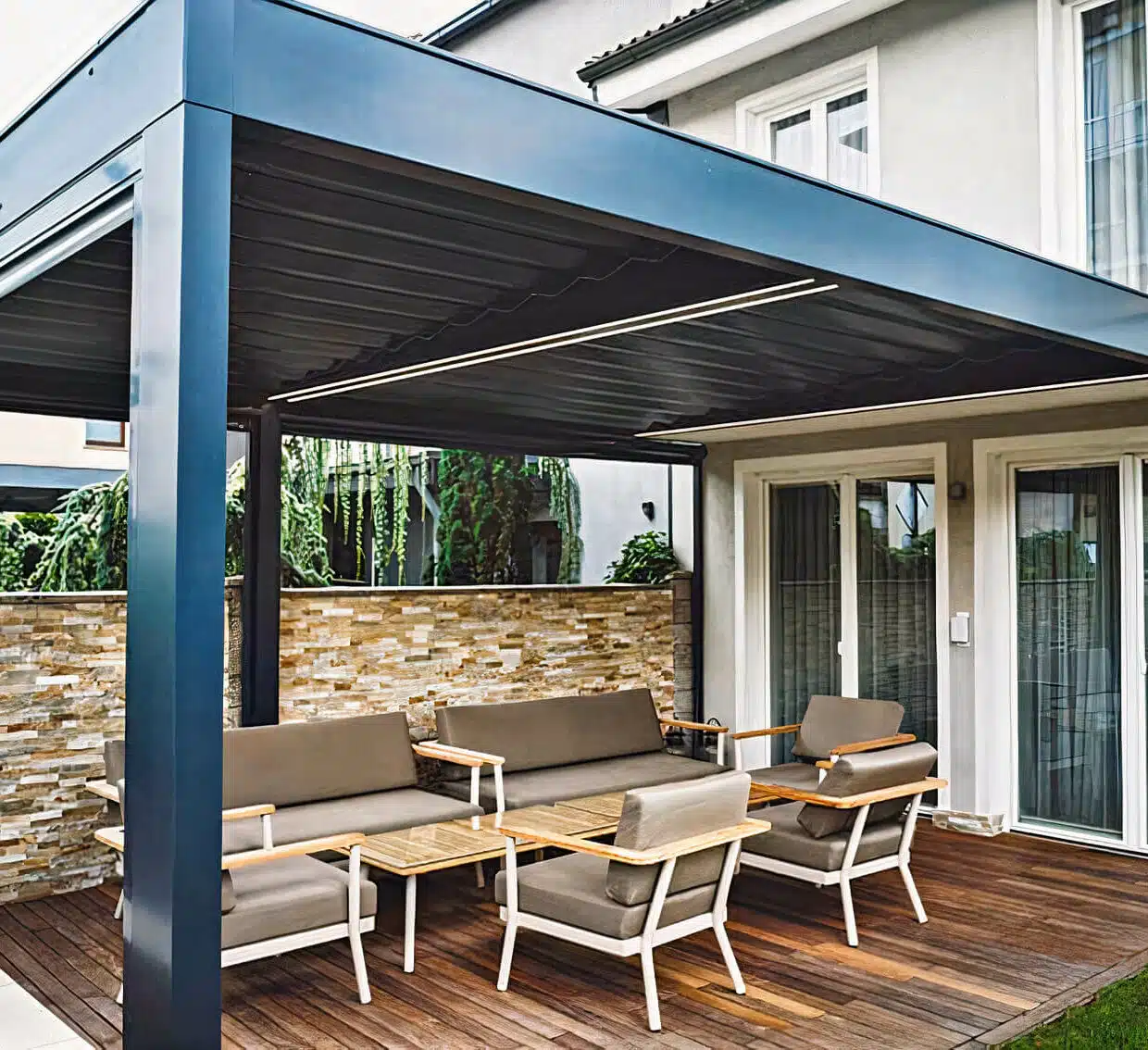Aluminum awnings are a popular choice for many homeowners due to their durability and ability to withstand diverse weather conditions. However, exposure to the elements can leave these awnings covered in debris and dirt. Regular cleaning not only maintains their appearance but also extends their lifespan. A proper maintenance routine ensures that aluminum awnings remain an attractive and functional feature of any home.
The process of cleaning aluminum awnings involves removing loose debris, washing with appropriate cleaners, and rinsing thoroughly. It’s important to choose the right cleaning agents to prevent damage to the awning's surface. While the task may seem daunting, with the right tools and methods, it can be accomplished effectively and with minimal effort. It is recommended to clean the awnings periodically to avoid the accumulation of stubborn grime, which can be harder to remove over time.

Preparing to Clean Aluminum Awnings
Cleaning aluminum awnings effectively begins with assembling the right tools and taking appropriate safety measures. Proper preparation can prevent damage to the awnings and ensure personal safety during the cleaning process.
Assemble Cleaning Supplies
Before beginning the task, gather the following items:
- Cleaning Solutions: Prepare a mild detergent solution in a bucket using warm water mixed with dish soap, laundry detergent, or a specialized aluminum cleaner.
- Brushes and Sponges: Obtain a soft-bristled brush or sponge to avoid scratching the aluminum surface.
- Garden Hose: Ensure a garden hose is available nearby for rinsing off the cleaning solution.
- Optional: For tougher dirt, a pressure washer set to a low pressure may be useful; however, use it with caution to prevent damage.
Safety Measures
Safety is paramount when cleaning awnings to avoid accidents and injury.
- Ladder Safety: If you need to reach high areas, use a sturdy ladder and place it on a firm and level surface. Avoid working alone if possible.
- Protective Gear: Wear non-slip shoes, gloves, and possibly goggles to protect from detergent splashes.
- Surroundings: Pay attention to the area around the awnings—protect any vinyl, concrete, or wood surfaces below from any runoff cleaning solution.
Remember to approach the task methodically, starting from the top and working down to ensure a thorough clean and avoid re-soiling cleaned sections.
Cleaning Process
The cleaning process for aluminum awnings involves a four-step sequence designed to remove debris, apply the appropriate cleaning solution, scrub thoroughly, and rinse off any residue to ensure a spotless finish.
Removing Loose Debris
To begin, they should spray down the awning with a garden hose set on a gentle stream to dislodge loose dirt, leaves, and other debris. If necessary, a broom can be used to sweep away any stubborn remnants.
Applying the Cleaning Solution
Next, readers create a cleaning mixture by diluting a mild detergent or a specific aluminum-friendly solvent in warm water. They then apply this solution to the awning using a spray bottle or a sponge, covering all areas evenly.
Scrubbing the Aluminum
Once the solution has been applied, they proceed with scrubbing the awning in a circular motion using a non-abrasive brush. Special attention should be given to spots with stubborn stains like bird droppings or mildew to ensure complete removal.
Rinsing the Awning
The final step requires rinsing the awning thoroughly with plain water to remove any soap residue. They should make sure that all cleaning agents have been washed off to prevent the deterioration of the aluminum’s protective coating.
Drying and Preventing Water Damage
After cleaning an aluminum awning, it is essential to dry it thoroughly to prevent water from accumulating. Trapped moisture can lead to damage over time, potentially undermining the structural integrity of the awning and leading to rust or mold growth.
Steps to Ensure Proper Drying:
- Tilt the Awning: If possible, adjusting the awning’s angle can facilitate water runoff, reducing moisture retention.
- Air Dry: Allow the awning to air dry completely before retracting. Preferably, choose a day with ample sunlight and low humidity to expedite the drying process.
- Remove Pooled Water: After washing, inspect for pooled water. Use a soft cloth or a squeegee to gently remove excess water from the surface.
To prevent water damage, locating awnings in an area with sufficient air circulation and shade can be beneficial. This positioning helps to:
- Minimize direct exposure to rainwater
- Provide a cooler environment, reducing the likelihood of heat-related expansion and contraction that may cause cracks or other damage
Preventative Maintenance:
- Regular Inspections: Check the awning routinely for signs of wear and tear, especially after severe weather conditions.
- Sealant Application: Apply a protective sealant to the awning to create a barrier against moisture and environmental elements.
- Prompt Repairs: Address any visible damage or corrosion immediately to prevent magnification of the issue.
By incorporating these techniques into regular maintenance, one can extend the life of an aluminum awning and protect it from premature wear due to moisture-related damage.
Maintaining Aluminum Awnings
Proper maintenance of aluminum awnings involves a disciplined approach to cleaning and inspecting. This section outlines best practices for upkeeping these structures to ensure they remain visually pleasing and functional.
Regular Cleaning Schedule
Frequency: Homeowners should clean their aluminum awnings at least twice a year. However, awnings in areas with heavy exposure to dirt or pollution may require more frequent cleaning.
Equipment:
- Garden hose with a gentle spray setting
- Soft-bristled brush
- Bucket with warm water
- Mild detergent
Steps:
- Spray awnings with the garden hose to remove loose dirt and debris.
- Mix warm water with a mild detergent in a bucket.
- Scrub the awning gently with a soft-bristled brush dipped in the soapy mixture.
- Rinse thoroughly with the garden hose to remove soap residue.
- Dry the awning to prevent water spots; a squeegee can expedite this process.
Inspecting for Structural Damage
Inspection Timing: A thorough inspection should be conducted during each scheduled cleaning.
Areas to Inspect:
- Connections and mounts: for loosening or corrosion.
- Support arms: for signs of bending or weakness.
- Surface: for cracks, scratches, or discoloration.
Actions:
- Tighten any loose bolts or mounts to prevent further wear.
- Treat any minor corrosion or scratches to stop them from spreading.
- Consult a professional if significant damage is found to ensure proper repair.
Regular maintenance and inspection not only prolong the life of aluminum awnings but also contribute positively to curb appeal. It preserves the awning’s function and appearance, mitigating the need for costly replacements or repairs.
Avoiding Common Cleaning Mistakes
When cleaning aluminum awnings, certain missteps can cause damage, diminishing both their appearance and longevity. It’s crucial to select the right tools and substances for this delicate task. Here are some common mistakes to avoid:
- Using Abrasive Materials: Refrain from using abrasive materials such as steel wool or harsh scrubbing brushes. These can scratch the aluminum’s surface, leading to unsightly marks. Using a soft-bristle brush will ensure effective cleaning without causing damage.
- Improper Chemicals: Exercise caution when choosing cleaning solutions. Harsh chemicals like bleach, ammonia, or solvents that contain sodium hypochlorite can corrode aluminum awnings. Opt for mild detergents diluted with water as a safer alternative.
- Excessive Water Pressure: While using a power washer might seem efficient, the intense water pressure can bend or dent the awnings. It’s safer to use a garden hose with a gentle spray setting to rinse off cleaning residues.
| Do | Don’t |
|---|---|
| Use a soft-bristle brush. | Use abrasive tools for scrubbing. |
| Opt for mild detergents or soaps. | Use harsh chemicals like bleach or ammonia. |
| Gently rinse with a garden hose. | Use a power washer. |
- Ignoring Oxidation: Signs of oxidation, such as a chalky residue, should not be overlooked. When painting over an oxidized surface, it’s important to remove all residue before applying an oil-based primer followed by suitable latex or acrylic paint specifically designed for aluminum surfaces.
Remain attentive to the awning manufacturer’s guidelines. They may recommend specific cleaning agents or methods best suited for their product. This adherence will not only clean effectively but also preserve the integrity and aesthetic of the aluminum awnings.
Frequently Asked Questions
These questions cover common concerns regarding the maintenance and cleaning of aluminum awnings.
What is the most effective method for cleaning mold off an aluminum awning?
To remove mold from an aluminum awning, it is advisable to use a solution of warm water and a mild detergent or specialized aluminum cleaner. Apply with a soft brush and rinse thoroughly.
What solutions are recommended for washing aluminum awnings without detachment?
They can wash aluminum awnings in place by using a solution of warm water and a gentle soap, such as dishwashing liquid or car wash soap. Apply with a soft-bristled brush, then rinse with water from a garden hose.
Can vinegar be used to safely clean aluminum awnings, and if so, how?
Vinegar, diluted with water, can be used to clean aluminum awnings. A ratio of 50/50 vinegar and water is typically effective for spot cleaning and removing light stains and residue.
How can aluminum awnings be restored to look new?
To restore aluminum awnings, thoroughly clean them with a non-abrasive cleaner, and then apply a quality metal polish or a coat of specialized aluminum paint, following the manufacturer’s guidelines.
Is it possible to pressure wash aluminum awnings, and what precautions should be taken?
Pressure washing is possible but should be done with caution. Use a low-pressure setting and keep a safe distance to avoid damaging the awning’s finish. It’s best to test a small area first.
What steps are needed to clean and repaint aluminum awnings successfully?
Cleaning and repainting involve washing the awning with a mild detergent, thorough rinsing, drying, and then applying a primer and paint designed for aluminum. Each step should be done meticulously to ensure adhesion and longevity.
Speak To The Awning Pros At Valrose
If you’d rather leave cleaning and maintaining your aluminum awnings to the pros, Valrose can help. We are available for one-time cleanings, scheduled maintenance, awning repairs, and even full awning replacements if you think it’s time to replace your shade structures.
Want to find out more about our awning services and maintenance solutions? Contact Valrose today to discuss your project with one of our shade experts.






